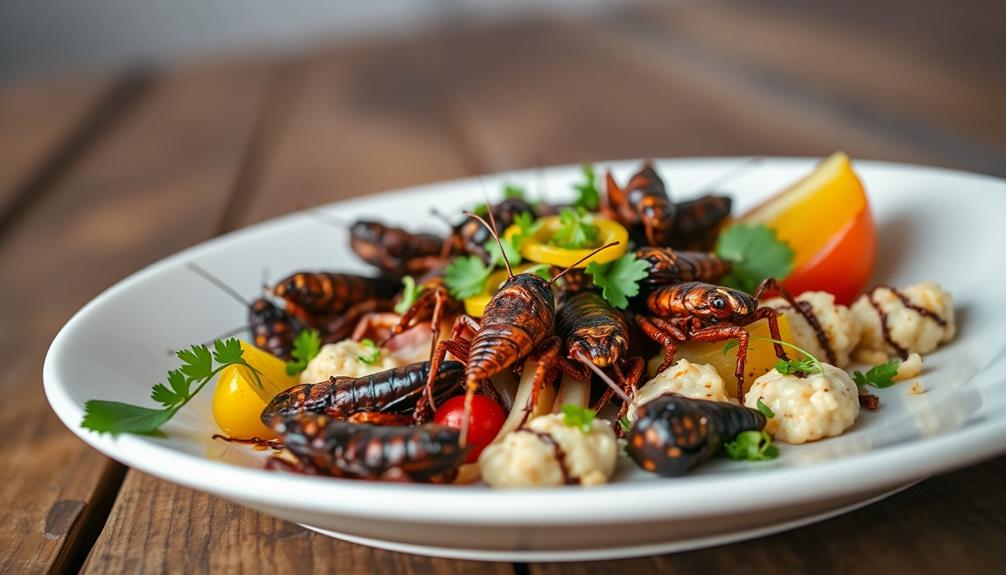Eating insects in Western cultures challenges your perceptions, rooted in cultural biases and disgust. Many view insects as unclean, which creates strong psychological barriers to acceptance. This food neophobia, or fear of trying unfamiliar foods, heightens resistance to insects as a viable food source. However, familiarity through culinary exposure and educational initiatives can reduce these feelings. As you begin to understand the nutritional and environmental benefits, like high protein content and sustainability, your mindset may shift. This evolving perspective is shaping a new acceptance of edible insects that's worth exploring.
Key Takeaways
- Food neophobia in Western cultures contributes to reluctance in trying insects, often leading to negative psychological associations and disgust.
- Disgust significantly influences perceptions of insects, creating barriers to acceptance and willingness to incorporate them into diets.
- Familiarity with certain edible insects can reduce disgust responses, promoting greater acceptance over time.
- Processed insect products are generally more accepted than whole insects, as they minimize visible insect traits that evoke discomfort.
- Educational initiatives and culinary innovations are essential in reshaping perceptions of insect consumption and overcoming psychological barriers.
Cultural Perspectives on Insects
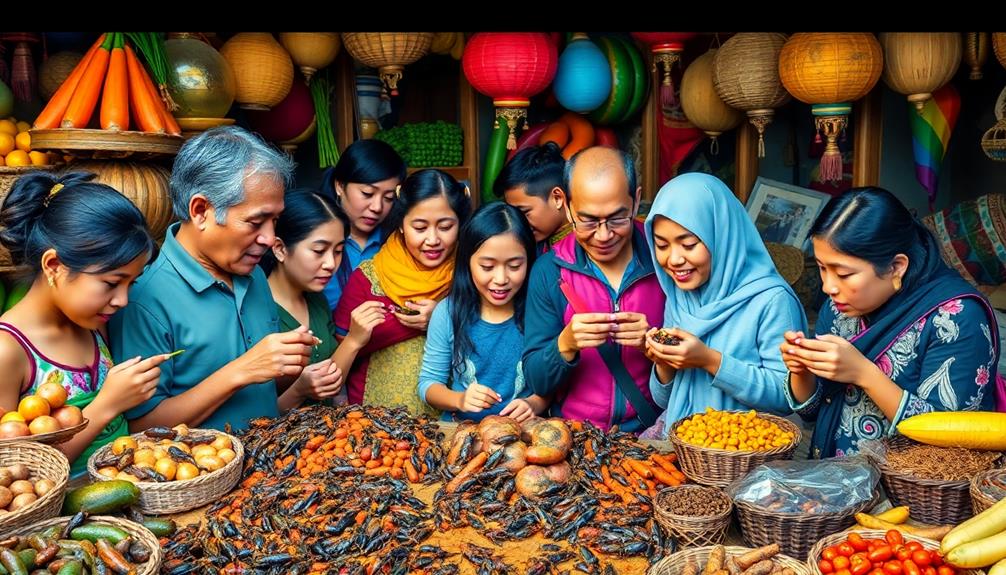
Cultural perceptions of insects vary dramatically around the world, shaping how societies view them as a food source. In Western cultures, you might find that insects are often seen as dirty or disgusting, which greatly hinders their acceptance as food. This perspective contrasts sharply with cultures where entomophagy is normalized, leading to a more favorable view.
For instance, many traditional Brazilian dishes reflect a rich blend of cultural influences, showcasing how diverse ingredients can be embraced in cuisine, much like how insects can be integrated into modern recipes regional culinary traditions. Historical evidence shows that while certain insects were once consumed widely, changing cultural attitudes have diminished this practice in the West.
When focus groups in countries like Italy express curiosity about insects, that interest quickly shifts to disgust, rooted in unfamiliarity and cultural biases. Similarly, in Hungary and Switzerland, insects evoke strong negative emotions, resulting in low interest in trying them.
However, addressing food neophobia is essential for shifting these cultural perspectives. Communicating the nutritional and environmental benefits of edible insects could help reduce psychological barriers.
Food Neophobia Explained

Food neophobia is your reluctance to try unfamiliar foods, and it affects many people's willingness to consume insects.
In Western cultures, this reluctance is often shaped by cultural norms and negative associations with insects. For instance, while dishes like Mushroom Masala highlight the acceptance of certain fungi, the thought of eating insects can evoke discomfort.
Understanding these influences can help you see why acceptance of edible insects remains low in these societies.
Definition of Food Neophobia
Many people experience reluctance when it comes to trying unfamiliar foods, a phenomenon known as food neophobia. This reluctance often leads to avoidance behaviors, especially towards novel food items like insects.
In cultures that embrace diverse culinary traditions, such as those featuring Red-Braised Pork Belly, individuals may be more open to exploring new flavors. Fundamentally, food neophobia is defined as the fear or aversion to trying new foods, which can stem from various psychological factors.
One common way to measure food neophobia is through the Food Neophobia Scale (FNS). Higher scores on this scale indicate greater resistance to exploring diverse culinary options.
In Western cultures, research shows that individuals tend to exhibit higher levels of food neophobia compared to regions where insect consumption, or entomophagy, is more accepted. Disgust plays a significant role here, as negative cultural perceptions contribute to your reluctance to embrace these unfamiliar foods.
Interestingly, studies reveal that familiarity can help alleviate food neophobia over time. As you become more exposed to insect consumption through education and experience, your acceptance may improve.
Understanding this psychological barrier is vital for promoting alternative protein sources like insects, especially in cultures where such foods are still viewed with skepticism.
Cultural Influences on Acceptance
Psychological factors greatly shape your acceptance of new foods, especially insects. Food neophobia, or the reluctance to try unfamiliar foods, is prevalent in Western cultures and greatly impacts how you perceive insects as a food source. If you have high food neophobia, you might experience strong disgust towards insects, making it harder for you to embrace them compared to cultures with a history of eating insects.
Cultural influences play a key role in food neophobia. For instance, studies show that German adults exhibit higher food neophobia regarding insects than their Chinese counterparts, who have a more open attitude. Understanding these cultural differences can help shift your perspective towards insect consumption, as altering implicit attitudes can reduce disgust.
Here's a summary of how cultural influences affect acceptance:
| Cultural Context | Food Neophobia Level | Insect Acceptance | Common Attitudes | Traditional Practices |
|---|---|---|---|---|
| Western Cultures | High | Low | Insects seen as unclean | Minimal to none |
| Eastern Cultures | Low | High | Insects seen as nutritious | Common in diets |
Recognizing these influences can help you navigate your feelings about eating insects more effectively.
Disgust and Insect Consumption

When it comes to eating insects, disgust plays a pivotal role in shaping perceptions and choices, particularly in Western cultures. This strong aversion often stems from food neophobia, which is the avoidance of unfamiliar foods. You might find that your reluctance to try insect-based foods is heightened due to cultural norms that view insects as unappetizing.
Studies show that implicit attitudes toward insects markedly influence levels of disgust, impacting your willingness to incorporate them into your diet. Curiously, familiarity can lessen these feelings; for instance, you may be more open to eating mealworms or crickets than cockroaches.
As you navigate these feelings, understanding that acceptance of insect consumption varies across cultures can be enlightening. Communication strategies that highlight the nutritional and environmental benefits of insects may help challenge your disgust response.
Nutritional Benefits of Insects
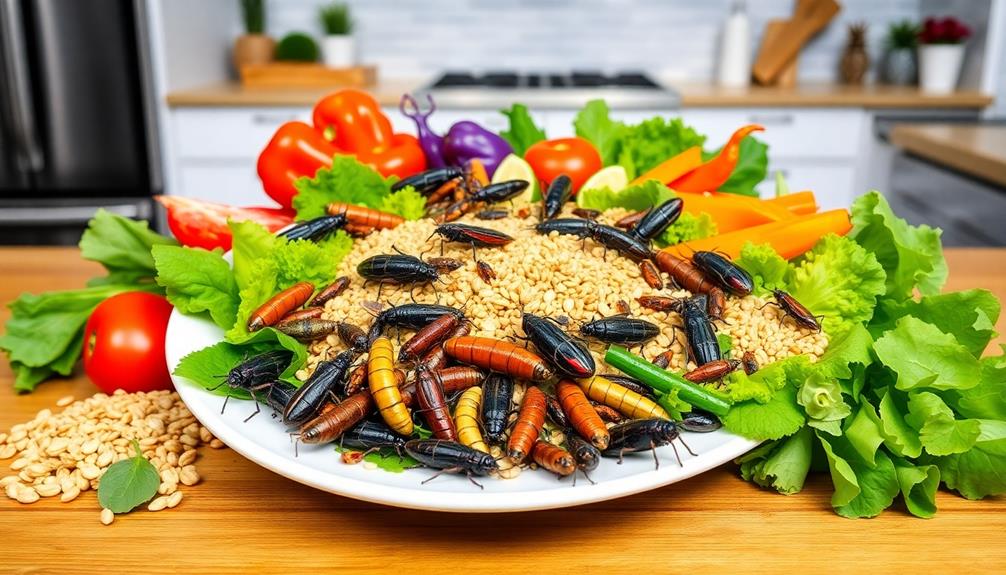
Shifting your focus from the emotional barriers surrounding insect consumption, it's important to recognize the substantial nutritional benefits these critters offer. Edible insects, like crickets and mealworms, boast an impressive protein content of 54-58%, making them excellent protein sources compared to traditional meats. Their high-quality protein isn't only digestible but also comparable to that from conventional animal sources, ensuring you're getting the nutrients your body needs.
Beyond protein, insects are rich in essential fatty acids, vitamins, and minerals, contributing to a well-rounded diet. This can be particularly beneficial in addressing nutritional deficiencies found in certain populations.
Additionally, the favorable amino acid profile of these insects provides essential amino acids that your body can't synthesize on its own, vital for maintaining overall health.
Moreover, edible insects typically contain lower levels of hazardous chemicals than traditional livestock, enhancing their appeal as a safe food option. By incorporating insects into your diet, you can enjoy their exceptional nutritional value while also diversifying your protein sources, leading to a healthier lifestyle.
Environmental Impact of Entomophagy

The environmental impact of entomophagy is significant, offering a sustainable alternative to traditional livestock farming. By consuming insects, you can contribute to a more efficient food system that fosters food security while minimizing greenhouse gas emissions. Insect farming requires fewer resources, such as land and water, meaning it leaves a smaller ecological footprint.
Here's a quick comparison of the benefits:
| Aspect | Traditional Livestock | Insect Farming |
|---|---|---|
| Greenhouse Gas Emissions | High | Low |
| Resource Efficiency | Low | High |
| Waste Reduction | Minimal | Significant |
| Contribution to Food Security | Limited | Enhanced |
Insects can convert organic waste into protein, addressing food waste issues and transforming by-products into valuable nutrients. This innovative approach not only improves resource efficiency but also helps combat climate change. By embracing entomophagy, you're supporting a more resilient food system that meets growing global demands. With its numerous environmental benefits, eating insects could be a vital step towards a sustainable future.
Overcoming Psychological Barriers
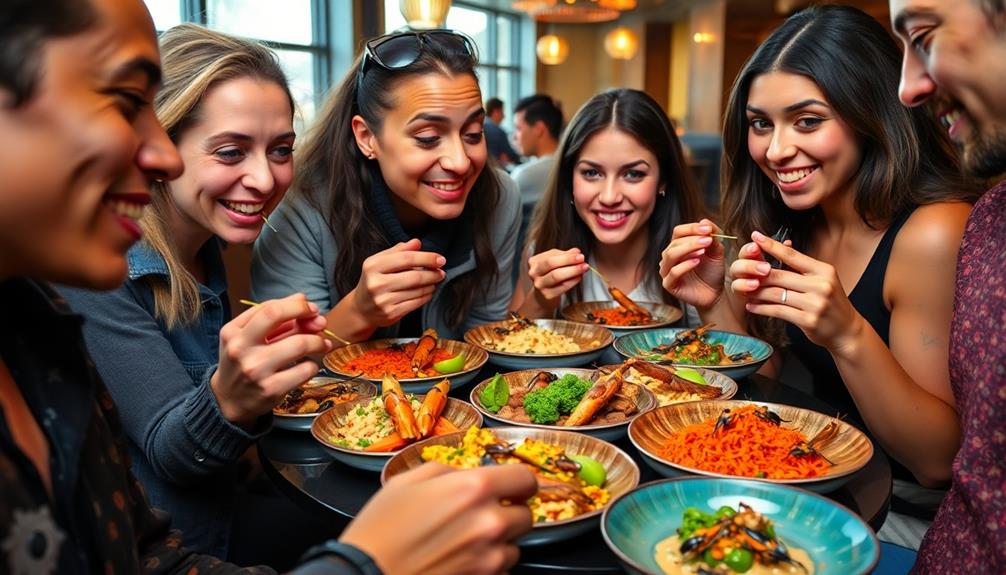
Overcoming psychological barriers to insect consumption requires a multifaceted approach that addresses deep-seated fears and biases. Food neophobia, the reluctance to try unfamiliar foods, greatly impacts your willingness to embrace insects as a food source. Higher neophobia scores often correlate with lower acceptance of insect-based products.
To tackle this, you can focus on changing emotional responses, especially feelings of disgust. By engaging in educational initiatives that highlight the nutritional and environmental benefits of insects, you can begin to mitigate negative perceptions. This knowledge can help shift implicit attitudes, making you more open to trying these foods.
Another effective strategy is to experience processed insect products, which minimize visible insect traits. These products tend to be more accepted, making it easier for you to take that first step into the world of entomophagy.
Additionally, participating in insect tasting events can familiarize you with specific species, further reducing food neophobia. The more you experience and learn about insects as food, the more positive your attitude will become, paving the way for broader acceptance in Western cultures.
Case Studies From Western Cultures
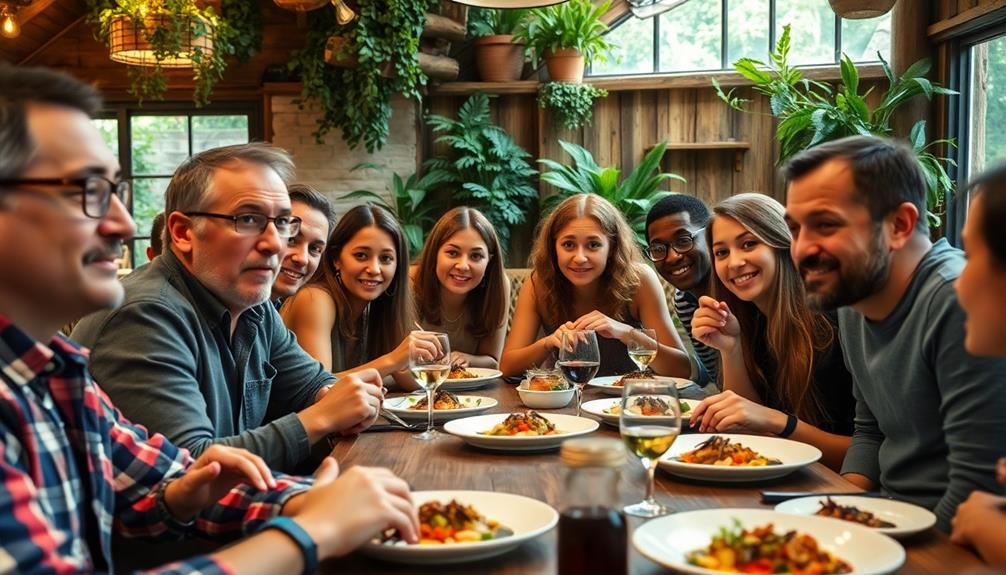
Exploring case studies from Western cultures reveals a complex landscape of attitudes toward insect consumption. Research highlights considerable psychological barriers, primarily driven by food neophobia.
In Italy, focus group studies show an initial curiosity surrounding insects, yet participants often express disgust, indicating a strong resistance to trying them (Balzan et al., 2016). Similarly, in Hungary, insects evoke exoticism but also strong negative emotions, resulting in low interest in their consumption (Gere et al., 2017).
Switzerland presents a stark aversion, where cultural biases against entomophagy lead to participants outright rejecting the idea of eating insects (Gmuer et al., 2016).
Here are some key points about the psychological effects of insect consumption in Western cultures:
- Cultural Heritage: Historical views label insects as dirty or disgusting, contributing to current aversions (Yen, 2009).
- Food Neophobia: This reluctance considerably hampers the acceptance of insects as a food source.
- Communication Efforts: Emphasizing the nutritional and environmental benefits might help shift attitudes toward greater acceptance.
Understanding these case studies provides valuable insight into the challenges faced in promoting insect consumption in Western cultures.
Changing Attitudes Towards Insects
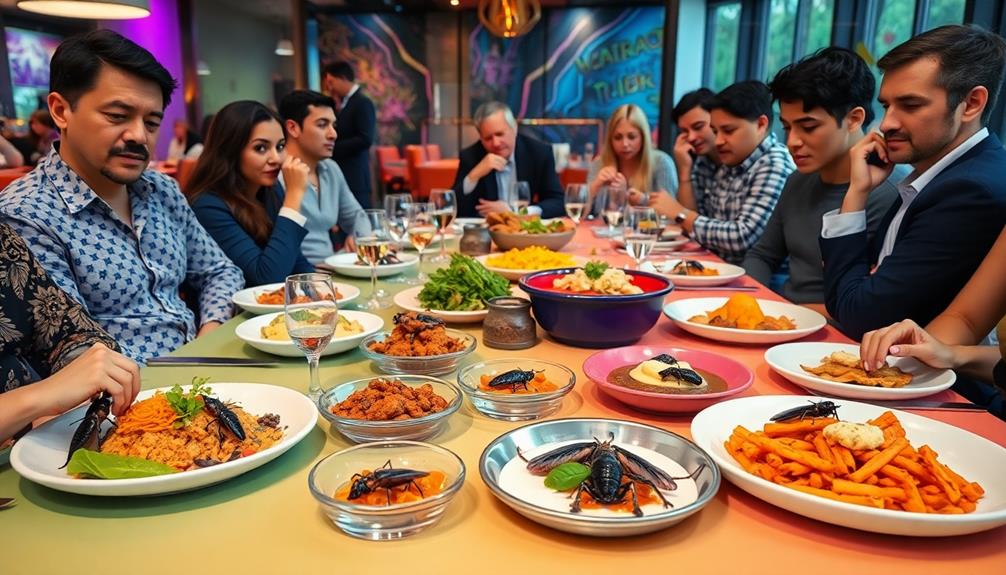
As you consider the idea of eating insects, you might notice a shift in cultural perceptions surrounding this practice.
Overcoming food neophobia is essential, and educational initiatives can play a significant role in easing your hesitations.
Cultural Shifts in Perception
While many people in Western societies have long viewed insects with aversion, recent cultural shifts are prompting a reevaluation of this perspective.
You might notice that attitudes towards edible insects are changing thanks to several key factors:
- Educational Initiatives: Programs highlighting the nutritional and environmental benefits of edible insects are reducing food neophobia, making people more open to trying them.
- Innovative Culinary Applications: Products like protein bars and insect-based snacks are hitting the market, showcasing insects as a viable and sustainable food source, which helps alter consumer attitudes.
- Culinary Tourism and Cultural Exchange: Exposure to diverse culinary practices through travel and cultural events encourages you to rethink previously held biases against eating insects.
As you explore these cultural shifts, it becomes clear that familiarity plays a significant role in acceptance.
While you might still feel uneasy about certain species, like cockroaches, growing exposure to more accepted options, such as mealworms and crickets, can foster a new perspective.
This gradual shift in perception could pave the way for wider acceptance of insect consumption in the future.
Overcoming Food Neophobia
Cultural shifts are paving the way for changing attitudes towards insect consumption, particularly in overcoming food neophobia. This reluctance to try unfamiliar foods considerably hampers acceptance of edible insects in Western cultures. You might find that your own food neophobia stems from psychological factors like disgust or implicit biases. These factors vary from person to person, influencing how willing you're to embrace insect consumption.
Interestingly, familiarity can help reduce food neophobia over time. The more you expose yourself to insects as food, the more you might begin to view them positively. Processed insect products, which hide the insects' animal traits, often gain more acceptance than whole insects, providing a potential pathway for overcoming your hesitations.
Additionally, marketing strategies that highlight the nutritional and environmental benefits of insects can help address these psychological barriers. By focusing on sensory experiences and the advantages of insect consumption, you can gradually shift your perspective.
Embracing these changes can lead to a broader acceptance of insects as a sustainable food source, ultimately changing your mindset towards this alternative protein option.
Educational Initiatives Impacting Acceptance
Educational initiatives are essential in shifting attitudes towards insect consumption, particularly by highlighting their nutritional value and environmental benefits. As you engage with these programs, you can see how they effectively reduce food neophobia and enhance acceptance of insect consumption.
Here are three impactful strategies:
- Experiential Learning: Cooking classes that feature insect-based recipes allow you to interact with the food directly, making it less intimidating and more familiar.
- Social Exposure: Tasting events create a relaxed environment where you can try insect-based foods among peers, helping normalize their consumption and shifting your perception from disgust to curiosity.
- Education on Safety and Processing: When you learn about how insects are safely processed and their benefits, you may feel more confident in trying these foods, alleviating concerns about hygiene and taste.
Educating Consumers on Insects

Increasing awareness about the benefits of eating insects is essential for changing consumer perceptions. You can play a part in this by engaging with educational initiatives that highlight the nutritional advantages of edible insects, such as their impressive protein content and micronutrients. Awareness campaigns can also emphasize how insects have a lower environmental impact compared to traditional livestock, which can greatly boost consumer acceptance.
Here's a quick overview of effective strategies to educate consumers:
| Strategy | Purpose | Impact on Consumer Acceptance |
|---|---|---|
| Nutritional Workshops | Highlight protein and micronutrient content | Increases knowledge and interest |
| Cooking Demonstrations | Provide sensory experiences | Reduces disgust and fosters curiosity |
| Familiarity with Products | Showcase processed insect foods | Decreases food neophobia |
| Cultural Context Sessions | Counter biases and stigmas | Encourages open-mindedness |
Future of Insect Consumption

As you explore the future of insect consumption, you'll notice cultural shifts in how people perceive these foods.
Education and awareness initiatives play an essential role in transforming attitudes, making insects a more accepted part of diets.
Innovations in food products featuring insects are paving the way for a more sustainable and nutritious culinary landscape.
Cultural Shifts in Perception
A significant cultural shift is underway regarding the perception of insect consumption, particularly in Western societies. While many still associate insects with dirt and disgust, changing attitudes reflect a growing openness.
Food neophobia has traditionally created barriers, but you may notice three emerging trends that are shifting cultural perceptions:
- Familiarity Breeds Acceptance: As you encounter familiar insect species like mealworms and crickets, acceptance increases. This contrasts sharply with the universal rejection of less appealing insects, like cockroaches.
- Sustainability Awareness: The sustainability and health benefits of edible insects are gaining traction. You might find that more people are recognizing their potential as a viable food source for the future.
- Culinary Exploration: Initiatives like culinary tourism are promoting cultural exchange. As you explore dishes featuring insects, your willingness to try these foods may grow.
Together, these trends indicate that insect consumption could become more normalized in the West.
Education and Awareness Initiatives
Education initiatives play an essential role in transforming perceptions about insect consumption. By highlighting the nutritional and environmental benefits of edible insects, these programs can help reduce the psychological barriers that contribute to food neophobia, especially in Western cultures.
Informative campaigns that emphasize the sustainability of insect farming, such as lower greenhouse gas emissions compared to traditional livestock, can shift public perceptions and boost consumer acceptance.
Sensory experiences, like tasting events and cooking demonstrations, also play a significant part in familiarizing you with insect-based dishes. As you sample these foods, you'll gradually overcome any initial hesitations.
Collaborative efforts involving chefs, nutritionists, and educators can create engaging programs that showcase the culinary potential of insects, making them a more accepted part of your diet.
Research shows that familiarity with specific insect species, like crickets and mealworms, enhances acceptance. Targeted educational approaches can help you develop a favorable attitude toward these commonly accepted insects.
Innovations in Food Products
Innovations in food products are reshaping how you perceive and consume insects. As brands respond to health and environmental concerns, they're introducing processed insects in ways that make them more acceptable to you.
By minimizing the visibility of insect traits, these products enhance food acceptance rates among consumers like you.
Here are three innovative approaches to insect consumption:
- Protein Bars and Snacks: These convenient options incorporate insect protein, making it easy for you to try something new without altering your routine too much.
- Insect Flour: This versatile ingredient can be added to familiar recipes, such as pasta and baked goods, seamlessly integrating the nutritional benefits of insects into your diet.
- Culinary Creativity: Chefs and food scientists are collaborating to create appealing insect-based dishes, challenging existing stigmas while aligning with traditional culinary practices.
Frequently Asked Questions
Why Do Westerners Hate Eating Bugs?
You might hate eating bugs because cultural perceptions label them as dirty and disgusting. Food neophobia plays a big role too, making you reluctant to try unfamiliar foods, reinforcing negative views about insects as a food source.
Why Is Eating Insects Taboo in the West?
Why do you think eating insects feels so taboo in the West? This aversion stems from cultural heritage, food neophobia, and historical perceptions that associate insects with dirtiness and disease, reinforcing their status as forbidden food.
What Are the Negative Effects of Eating Insects?
Eating insects can trigger strong disgust, causing nausea or anxiety. You might worry about safety, fearing harmful bacteria or allergens. This reluctance limits your dietary options and hinders potential benefits from sustainable protein sources.
Why Are People in the Western World More Likely to Eat Crickets in the Future?
You might think crickets are unappealing, but as you discover their high protein content and sustainability benefits, you'll see they're a delicious, eco-friendly alternative that fits perfectly into your health-conscious lifestyle.
Conclusion
As you explore the psychological effects of eating insects, you'll find that changing perceptions can lead to acceptance. By embracing the nutritional benefits, recognizing environmental impacts, and confronting food neophobia, you can challenge ingrained disgust. You'll open yourself to new culinary experiences, contribute to sustainability, and pave the way for a healthier future. Insects aren't just a source of protein; they're a step towards a more inclusive and innovative food culture. So why not take the leap?
